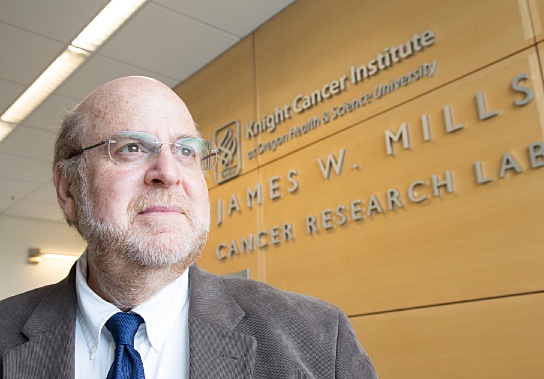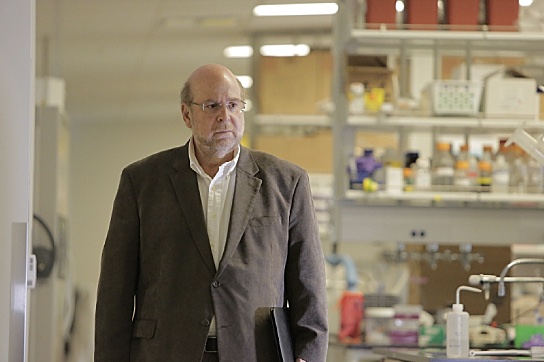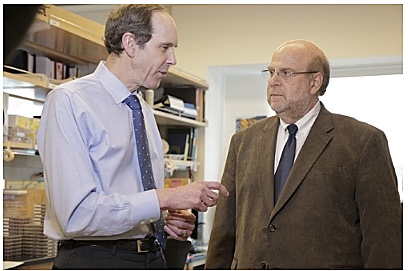 The Oregon Health & Science University (OHSU) Knight Cancer Institute has recruited scientific innovator and nanotechnology engineer Sadik Esener, Ph.D. as director of the KCI’s new Center for Early Detection Research.
The Oregon Health & Science University (OHSU) Knight Cancer Institute has recruited scientific innovator and nanotechnology engineer Sadik Esener, Ph.D. as director of the KCI’s new Center for Early Detection Research.
Esener will head up fast-track recruitment to the Knight Cancer  Institute’s Center for Early Detection of “a small army” — a world-class multidisciplinary team of 250 to 300 scientists and physician investigators to be led by 20 to 30 of the world’s top cancer researchers and their staffs from varied backgrounds, including the fields of cancer biology, oncology, and medical engineering, all focused on a common goal: to take on the biggest unmet need in cancer care today, detecting lethal cancers before they gain a foothold in the body and early enough that treatment has a higher probability of success.
Institute’s Center for Early Detection of “a small army” — a world-class multidisciplinary team of 250 to 300 scientists and physician investigators to be led by 20 to 30 of the world’s top cancer researchers and their staffs from varied backgrounds, including the fields of cancer biology, oncology, and medical engineering, all focused on a common goal: to take on the biggest unmet need in cancer care today, detecting lethal cancers before they gain a foothold in the body and early enough that treatment has a higher probability of success.
OHSU’s recruitment of Esener and the new team was enabled by meeting a $1 billion fundraising challenge by Nike co-founder Phil Knight and his wife Penny that triggered the Knights’ gift pledge, which sets a new philanthropic record. OHSU beat the Knights’ deadline by seven months and was successful in attracting support from more than 10,000 donors from every U.S. state and five other countries who were inspired by KCI’s plans for the first grand-scale program of its kind dedicated to radically transforming early detection of lethal cancers.
With the $1 billion in new funding, the investigative team will have the financial support they need to ensure they can focus on research rather than on solicitation and administration of grants.
Esener’s own research achievements span a range of scientific fields relevant to early detection research, including electrical and optical engineering, nano-engineering and material sciences for biomedical applications and development of diagnostic biochips, to creating nanoscale cancer-fighting “smart bullets” that have the potential to perform a range of functions, from capturing biomarkers to delivering drug treatments directly to tumor cells.
“I can look at problems from different angles, and cancer is a very complicated problem,” said Esener, who has been awarded the Wendt Family Endowed Chair in Early Cancer Detection and has an extensive background in bringing together scientists and technology from various disciplines to provide compelling solutions to previously unsolved challenges in biomedicine, and a strong track record in innovation.
Technology he developed has launched half a dozen startup companies to make his inventions accessible to the scientific and medical communities, including five from his labs at the University of California San Diego’s Jacobs School of Engineering, where he was a professor of nanoengineering, as well as electrical and computer engineering.
With Esener’s experience in multiple scientific fields relevant to early cancer detection research, including micro and nanofabrication and optical, electrical, and computer engineering, he has served as director and principal investigator of several centers of excellence in the areas of photonics and cancer nanotechnologies — most recently leading the Cancer Nanotechnology Center of Excellence, funded by the National Cancer Institute, at UCSD Moore’s Cancer Center in exploring ways to use nanoscale devices to detect and target cancerous tumors. One of his innovations was a micro-cannon five micrometers long — the thickness of spider silk — that fires nanobullets one micrometer in size.
In his new role at OHSU, Esener has also been awarded the Wendt Family Endowed Chair in Early Cancer Detection, funded by a generous gift from the Richard L. Wendt Family and the Wendt Family Foundation, that ensures ongoing support for his research role and is the second such endowment created by the Wendt family to advance efforts to end cancer.
 The Wendt family’s long-time support for the KCI began in 2001 with their funding of the JELD-WEN Chair of Leukemia Research held by the director of the OHSU Knight Cancer Institute, Brian Druker, M.D.. Druker is a Howard Hughes Medical Institute investigator and associate dean of oncology in the OHSU School of Medicine, whose own research has helped prove it possible to shut down cells that enable cancer to grow without harming healthy cells — a breakthrough that has led to development of new treatments that render once-fatal forms of the disease manageable. The KCI’s new large-scale research program dedicated to advancing precision early detection of lethal cancers will build on Drucker’s scientific leadership.
The Wendt family’s long-time support for the KCI began in 2001 with their funding of the JELD-WEN Chair of Leukemia Research held by the director of the OHSU Knight Cancer Institute, Brian Druker, M.D.. Druker is a Howard Hughes Medical Institute investigator and associate dean of oncology in the OHSU School of Medicine, whose own research has helped prove it possible to shut down cells that enable cancer to grow without harming healthy cells — a breakthrough that has led to development of new treatments that render once-fatal forms of the disease manageable. The KCI’s new large-scale research program dedicated to advancing precision early detection of lethal cancers will build on Drucker’s scientific leadership.
“Our goal requires that we completely reimagine early detection, so we were insistent on recruiting a leader with a track record in game-changing innovation,” Druker said in a press release. “We needed someone with proven skill in both assembling and leading a highly diverse team of life scientists, engineers, and computational experts in a unified direction. There are an extremely small number of individuals with this combination of skills and experience, and Sadik Esener is among them.”
“I was drawn to OHSU because the leadership shares my dedication to effectively integrate disciplines such as cancer biology, oncology, and medical engineering to focus on the challenge of cancer early detection,” Esener said. “We are at a pivotal scientific moment as many new approaches such as fluid biopsies for detection and immunotherapies for treatment are emerging. My goal is to build a team that will leverage the pioneering work already underway at OHSU as well as the global collaborations it is developing to break ground in this area.”
Esener has been personally touched in the war against cancer, having lost both his wife and his mother to the disease. “I got involved with cancer before it hit my family,” he said in an OHSU profile. “But when my wife was diagnosed with colorectal cancer, and a few weeks later my mother was diagnosed with pancreatic cancer — it affects you tremendously.”
Notwithstanding his personal loss to the disease, Esener affirms that, “We can be cautiously optimistic nowadays. Collectively, we are at a pivotal scientific moment because many new approaches such as fluid biopsies for detection and immunotherapies for treatment are presently emerging from research laboratories.”
Leveraging science already in progress at the OHSU Knight Cancer Institute, one of the new program’s first projects will will be to develop liquid biopsy biochips that can serve as early warning tools to assess disease risk. Early detection of lethal forms of cancer is crucial to realize the full promise of precision cancer medicine.
Fully understanding how molecular drivers of the many forms of cancer work enables more precise detection, diagnosis, and treatment of the disease.
Esener is expected to take up his post at OHSU this summer. “I’m looking forward to finding solutions to this important problem,” he says. “We have an opportunity here to make a real impact on this terrible disease.”
Video – http://origin-qps.onstreammedia.com/origin/multivu_archive/PRNA/ENR/Dr Esener Interview.mp4
For more information, visit:
http://www.ohsu.edu/xd





